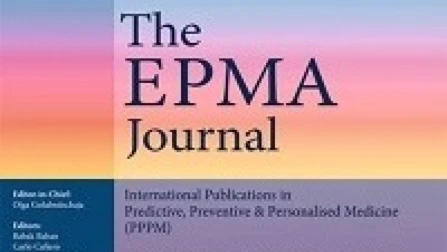Editor-in-Chief Highlights: September 2023
View the latest Editor-in-Chief highlights from EPMA Journal.

View the latest Editor-in-Chief highlights from EPMA Journal.

View the latest Editor-in-Chief highlights from EPMA Journal.


Pituitary neuroendocrine tumors (PitNETs) are the second most common primary central nervous system tumors in adults. Among them, non-functional PitNET (NF-PitNET), a PitNET with hormone synthesis but without hormone hypersecretion symptoms, is accounted for 15 ~ 54%. A series of molecules are involved in NF-PitNET pathogenesis that alter in multiple levels of genome, transcriptome, proteome, and metabolome. These molecules mutually interact to form dynamically associated molecular-network systems.
In this review article, Wen and colleagues explore the current knowledge of single omics and integrative omics of NF-PitNETs and highlight key signaling pathways and signaling pathway network alterations identified from multi-omics data. Researcher emphasized the altered signaling pathways and their key molecules related to NF-PitNET invasiveness and aggressiveness that are challenging clinical problems.

View the latest Editor-in-Chief highlights from EPMA Journal.

View the latest Editor-in-Chief highlights from EPMA Journal.

An increasing interest in a healthy lifestyle raises questions about optimal body weight. It should be clearly discriminated between the standardised “normal” body weight and individually optimal weight, and the basic principle of personalised medicine “one size does not fit all” has to be applied.
Development of innovative screening programmes is essential to promote population health by application of individualised patient profiling, multi-parametric analysis leading to cost-effective targeted prevention.
In a long-term way, a significantly improved healthcare economy is one of the clear benefits of the proposed paradigm shift from reactive medicine to 3PM; a tight collaboration between all stakeholders including scientific community, healthcare providers, patient organisations, policy-makers and educators is essential for the smooth implementation of the 3PM concepts.

View the latest Editor-in-Chief highlights from EPMA Journal.

SCImago Journal Rank (SJR) measures weighted citations received by the journal. In 2020, the SJR for EPMA Journal is 1.177 (this opens in a new tab), placing it in the 1st quartile of the 'Health Policy' category, with particularly high level of international collaboration amongst researchers.
Scopus CiteSore measures average citations received per document published. The 2020 CiteSore for EPMA Journal is 9.000 (this opens in a new tab). This ranks the journal as 5th in the 'Health Policy' category, within the 98th percentile.
Source-Normalized Impact per Paper (SNIP) measures actual citations received relative to citations expected for the journal’s subject field. The 2020 SNIP for EPMA Journal is 1.422 (this opens in a new tab).
In this Q&A, Prof Dr Olga Golubnitschaja (this opens in a new tab), Editor-in-Chief, joins us to discuss the developments in the field of 3P medicine and the impact that the EPMA Journal has had over the last decade.
Prof Golubnitschaja also shares with us her latest research and thoughts on how 3PM will continue to develop in the coming years.

Oral cavity health is pivotal for prediction and prevention of associated pathologies. Inadequately provided oral health services in populations are caused by multi-factorial deficits.
In this study, researchers investigated a variety of factors to determine key parameters for patient stratification considering person-tailored approach in a complex dental care in the population.

View the latest Editor-in-Chief highlights from EPMA Journal.

Chronic liver disease management is a comprehensive approach requiring multi-professional expertise and well-orchestrated healthcare measures thoroughly organized by responsible medical units. The corresponding multi-faceted chain of healthcare events is likely to be severely disturbed or even temporarily broken under the force majeure conditions such as global pandemics. Consequently, the chronic liver disease is highly representative for the management of any severe chronic disorder under lasting pandemics with unprecedented numbers of acutely diseased persons who, together with the chronically sick patient cohorts, have to be treated using the given capacity of healthcare systems with their limited resources.
In this study, researchers explored the potential negative impact of the SARS CoV-2 outbreak on the quality of the advanced chronic liver disease (ACLD) management by considering two well-classified parameters: (1) the continuity of the patient registrations and (2) the level of mortality rates, comparing pre-COVID-19 statistics with these under the current pandemic in Slovak Republic.

View the latest Editor-in-Chief highlights from EPMA Journal.

View the latest Editor-in-Chief highlights from EPMA Journal.

Societies around the world are facing the paradoxal epidemic development of prostate cancer (PCa) as a non-communicable disease. PCa is the most frequently diagnosed cancer for men in several countries such as the USA. Permanently improving diagnostics and treatments in the PCa management causes an impressive divergence between, on one hand, permanently increasing numbers of diagnosed PCa cases and, on the other hand, stable or even slightly decreasing mortality rates.
The article (this opens in a new tab) summarises knowledge accumulated in regard to the PCa-relevant non-modifiable and modifiable risk factors, highlights current deficits in PCa managements and presents innovative solutions in the context of predictive, preventive and personalised (3P) medicine.

SCImago Journal Rank (SJR) measures weighted citations received by the journal. In 2019, the SJR for EPMA Journal is 1.263 (this opens in a new tab), placing it in the 1st quartile of the 'Health Policy' category, with particularly high level of international collaboration amongst researchers.
Scopus CiteSore measures average citations received per document published. The 2019 CiteSore for EPMA Journal is 7.700 (this opens in a new tab). This ranks the journal as 8th in the 'Health Policy' category, within the 96th percentile.
Source-Normalized Impact per Paper (SNIP) measures actual citations received relative to citations expected for the journal’s subject field. The 2019 SNIP for EPMA Journal is 1.469 (this opens in a new tab).
View the latest Editor-in-Chief highlights from EPMA Journal.

As a result of the significant disruption that is being caused by the COVID-19 pandemic we are very aware that many researchers will have difficulty in meeting the timelines associated with our peer review process during normal times. Please do let us know if you need additional time. Our systems will continue to remind you of the original timelines but we intend to be highly flexible at this time.
Prof. Dr. Golubnitschaja is the head of the world first Predictive, Preventive Personalised (3P) Medicine unit at the Department of Radiation Oncology, University Hospital Bonn, Rheinische Friedrich-Wilhelms-Universität Bonn, Germany. OG is educated in journalism, biotechnology and medicine and has been awarded research fellowships in Austria, Russia, UK, Germany, Netherlands, and Switzerland (early and predictive diagnostics in paediatrics, neurosciences and cancer).
